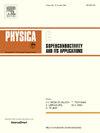Numerical simulation and design of superconducting cusp magnet for 400 mm Magnetic-field-applied Czochralski (MCZ) single crystal silicon growth
IF 1
3区 物理与天体物理
Q4 PHYSICS, APPLIED
Physica C-superconductivity and Its Applications
Pub Date : 2025-06-02
DOI:10.1016/j.physc.2025.1354721
引用次数: 0
Abstract
Single crystal silicon is currently used for the production of chips and solar cells, commonly prepared using the Magnetic-field-applied Czochralski (MCZ) method. However, during the crystal growth process, the uneven heating distribution induces a strong thermal convection effect in the melt, which facilitates the doping of the crystal with oxygen impurities and affects the quality of the produced crystals. With the implementation of the cusp magnetic field method, the melt convection can be effectively suppressed. Two symmetrically placed superconducting coils generate a cusp magnetic field by passing currents in opposite directions. In this work, we selected a 42-inch crucible to prepare a single crystal silicon with a diameter of 400 mm. We systematically investigated the convective inhibition effect of the magnetic field by comparing the flow and temperature fields of the melt with and without the applied cusp magnetic field. To achieve a radial magnetic flux density (Br) greater than 1000 G at the crucible wall, the parameters of the two superconducting coils were optimized. Based on the optimization results, we fabricated a YBCO high temperature superconducting (HTS) magnet with a coil inner radius of 900 mm and a coil spacing of 350 mm. The cooling structure and the tests were presented, which required 22 days to lower the coil’s temperature to 10.6 K. Finally, Br at the crucible wall was measured, yielding a good consistency with the simulated values.
400 mm磁场作用下chzochralski (MCZ)单晶硅生长超导尖磁体的数值模拟与设计
单晶硅目前用于生产芯片和太阳能电池,通常使用磁场应用的Czochralski (MCZ)方法制备。然而,在晶体生长过程中,加热分布不均匀导致熔体中产生强烈的热对流效应,有利于晶体中氧杂质的掺杂,影响晶体的质量。采用尖端磁场法可以有效地抑制熔体对流。两个对称放置的超导线圈通过相反方向的电流产生尖端磁场。在这项工作中,我们选择了42英寸的坩埚来制备直径为400mm的单晶硅。通过对比施加和不施加尖端磁场时熔体的流动场和温度场,系统地研究了磁场对对流的抑制作用。为了使坩埚壁径向磁通密度Br大于1000 G,对两个超导线圈的参数进行了优化。在优化结果的基础上,制备了线圈内半径为900 mm、线圈间距为350 mm的YBCO高温超导磁体。介绍了冷却结构和测试,需要22天才能将线圈的温度降低到10.6 K。最后对坩埚壁处的Br进行了测量,结果与模拟值吻合较好。
本文章由计算机程序翻译,如有差异,请以英文原文为准。
求助全文
约1分钟内获得全文
求助全文
来源期刊
CiteScore
2.70
自引率
11.80%
发文量
102
审稿时长
66 days
期刊介绍:
Physica C (Superconductivity and its Applications) publishes peer-reviewed papers on novel developments in the field of superconductivity. Topics include discovery of new superconducting materials and elucidation of their mechanisms, physics of vortex matter, enhancement of critical properties of superconductors, identification of novel properties and processing methods that improve their performance and promote new routes to applications of superconductivity.
The main goal of the journal is to publish:
1. Papers that substantially increase the understanding of the fundamental aspects and mechanisms of superconductivity and vortex matter through theoretical and experimental methods.
2. Papers that report on novel physical properties and processing of materials that substantially enhance their critical performance.
3. Papers that promote new or improved routes to applications of superconductivity and/or superconducting materials, and proof-of-concept novel proto-type superconducting devices.
The editors of the journal will select papers that are well written and based on thorough research that provide truly novel insights.

 求助内容:
求助内容: 应助结果提醒方式:
应助结果提醒方式:


